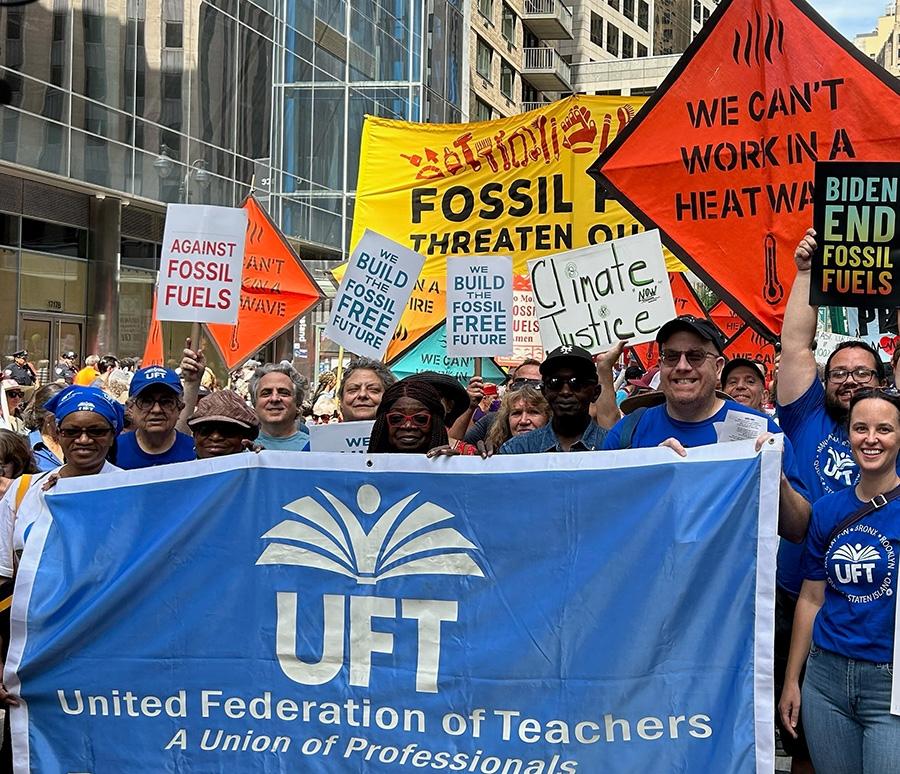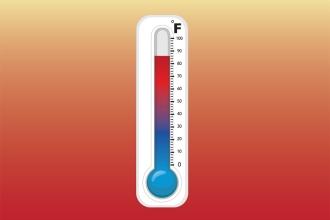Shedding light on a crisis

UFT members take part in the New York City Climate March in Manhattan this past September.
Between orange skies, extreme heat and dangerous floods, the effects of climate change are already having a serious impact on our lives in New York City. And yet, according to a 2021 survey of city educators, just slightly more than half of us teach students about climate change, and those who do only address it for about two hours per year.
A group of dedicated educators is trying to shift that paradigm. Joining forces through groups such as the Climate and Resilience Education Task Force and the DOE’s Climate Education Leadership Team, these educators advocate for policies to integrate climate education across the curriculum and produce teaching resources to speed their adoption.
With the introduction of four citywide Climate Action Days this school year, the DOE is finally recognizing the importance of climate education.
“New York City has begun taking strides in the right direction,” said Emily Fano, the senior manager of Climate Resilience Education for the National Wildlife Federation in New York City. In addition to the DOE’s Climate Action Days, climate education was included in the city’s updated strategic plan, PlaNYC.
“Climate education needs to be at the forefront of every curricular decision,” said Shakira Provasoli, a teacher at PS 333 in Manhattan and the winner of the Presidential Innovation Award for Environmental Educators. “To not teach students about what is really going on with our climate is to send them out into the world ill-equipped to design solutions to our current climate crisis.”
Students are deeply concerned about climate change; it’s often cited as the No. 1 issue they care about. Fano said many young people are aware of how global warming is affecting their communities and the world and “they believe that adults and governments have failed them by not taking action to stop the climate crisis.”
These educators stressed the importance of an appropriate climate education to meet the urgency of this moment.
Sarah Slack, a teacher at IS 223 in Brooklyn, has worked with NASA in Antarctica and, as a recipient of the Albert Einstein Distinguished Educator Fellowship, she is currently working with the U.S. Geological Survey on a national climate change curriculum. “Students want to understand what’s happening and why, and how we can help,” she said.
Many climate education leaders are science teachers since it’s a natural curricular fit. Sofia DiBari, an earth science teacher at Abraham Lincoln High School in Brooklyn, incorporates climate change into units from geologic history to erosion to astronomy.
But climate education can and should be woven into every subject area, these educators say.
Climate is a part of our everyday lives, so integrating it across the curriculum need not be challenging. “Climate impacts how we live and what we eat,” DiBari said.
She suggested starting with a discussion of current events. With the number of climate disasters in the news, she said, “you’ll end up covering many of the problems our society is facing today.”
Slack suggested reading climate-related poems for an English language arts class or articles about climate refugees in social studies. Teachers can incorporate climate change even in small ways. “If you change one graph in math from the number of apples to levels of greenhouse gas, you’re doing it,” she said.
Climate change can be an anxiety-producing topic, however, and we should be “mindful about how much loss, devastation and tragedy you expose adolescents to,” said DiBari.
DiBari suggests incorporating human resilience in any discussion of climate disasters. “After tragedies, communities unite and become stronger, which can be a more hopeful approach,” she said.
Fano said climate knowledge empowers students. “Things that are unknown are scary,” she said. “But knowing leads to understanding, and understanding leads to problem-solving. Action is the antidote to anxiety.”
Slack described a project from her classroom in which students used infrared thermometers to take the surface temperature of different areas of the school environment, such as patches of grass, classrooms or concrete. The students become indignant, she said, when they discover that their playground is 20 to 30 degrees hotter than other locations due to the blacktop.
“But their indignance is what leads them to start proposing change,” Slack said. They are spurred to devise ways to make the playground less hot, such as painting colored circles, planting trees and adding more green space. “They recognize improvements can be made to their own environment,” she said.
A climate education mandate in New York City schools would need to include professional learning opportunities for teachers on the science of global warming as well as the strategies to integrate it across the curriculum.
According to the ClimEd Survey conducted in New York City in 2021, 79% of teachers did not encounter climate change in their degree programs. “Given that number, it’s remarkable that many already teach it,” said Yadana Nath Desmond, the executive director of STEMteachersNYC and a member of the survey team.
However, the survey also showed that interest in climate education among New York City educators is strong. Three-quarters of the teachers surveyed said they would attend professional development on teaching climate change.
“Educating ourselves is key to be able to spread the message to students and to other adults,” said Provasoli.
Teachers who want to start integrating climate education in their classrooms should join “a community of like-minded educators,” Fano suggested.
STEMteachersNYC, in collaboration with NYC Parks, the American Museum of Natural History, the DOE’s Office of Energy and Sustainability and others, is launching a three-course microcredential with City College in January 2024 for New York City educators.
“This is an exciting opportunity for teachers to develop a coherent understanding of urban climate change,” said Nath Desmond.
Ultimately, the goal is to make students aware of the rapid changes to the environment and help them to develop agency to contribute solutions.
“Children have incredible ideas. They see around the corners adults set up for themselves,” said Nath Desmond. “They want learning that is active and creates change, and their input cannot wait.”
Climate educators want students to be empowered to face whatever lies ahead.
“I am inspired to educate the students who will be in charge of the world,” said Provasoli. “The future is in their hands.”
Lessons about climate change
If you are planning to create lesson plans related to the DOE's Climate Action Days or want to integrate the topic of climate change more regularly in your classroom, there are many high-quality materials online.
